Eight 5.1- And 7.1-Channel Gaming Headsets, Reviewed
Surround sound headsets are often more practical than a home theater system attached to your PC. We compare eight premium models from Arctic, Psyko, Cooler Master, Logitech, Creative, Thermaltake, Corsair, and Razer to figure out who sells the top option.
Cooler Master CM Storm Sirus
Cooler Master is another company expanding into the audio peripheral market, and its Sirus is part of the CM Storm gamer-oriented brand. These headphones offer true 5.1-channel surround via separate drivers for each audio channel.

This headset costs a more moderate $115, so we’re not surprised to see that Cooler Master amps up the fit and finish compared to Arctic's offering. The headphones look great (especially the illuminated red logo on the side of each ear cup). Although it weighs a hefty 13.3 oz, the Sirus is still comfortable, though perhaps a little tighter than we'd prefer to wear for long stretches of time.

The microphone can be deactivated by pushing the boom upward. When you do this, its red indicator light turns off. Our microphone tests demonstrate a bit of background noise and bright frequency response. The result is acceptable, though this isn't one of the best mics in our field of contenders.
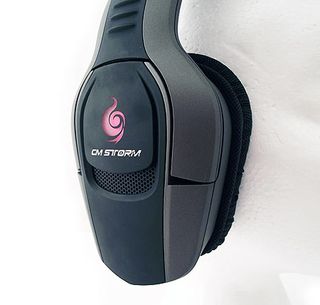

You probably wouldn't guess it by looking at the Sirus, but each of its ear cups has four speakers in it. The center, front, and rear surround drivers are all 30 mm large, while the subwoofers are 40 mm. The headphones are rated for frequency response between 10 Hz and 20 kHz. Relatively large subs do a good-enough job with bass that they can be set to overpowering levels.
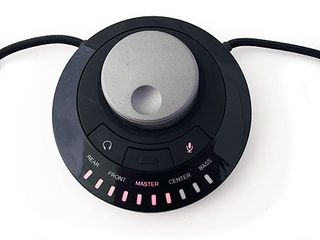
Cooler Master calls its control pod a tactical mixing console. It features headphone mute, microphone mute, and volume settings, along with rear, front, center, and sub channel level controls. The console also contains a USB audio chipset for folks who don't mind letting the headset handle processing. The large dial is smooth and heavy enough to sit on your desk. Its heft is much more satisfying than an inline remote with simple up and down buttons.
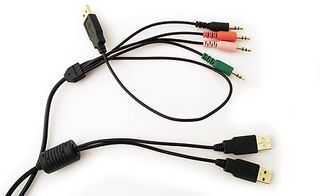
Cooler Master's bundle also comes with an analog cable adapter, if you'd prefer to use an add-in sound card for processing. The USB connector you see snaking off from that cable is used to power the illuminated logos.
Naturally, bypassing the tactical mixing console's integrated logic means that all adjustments need to go through your sound card's driver.
When you go the USB route, you're able to use the CM Storm Sirus' software for additional tuning beyond what the physical console facilitates. This utility isn't included, but Cooler Master does give you a download link instead.

The Speaker Settings page allows you to toggle between different surround sound modes.
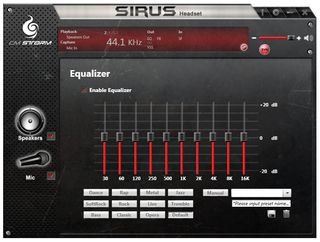
The Equalizer page is where you can customize sound spectrum preference.

The Flex Bass II page is used to more granularly control the headset's low-frequency response.
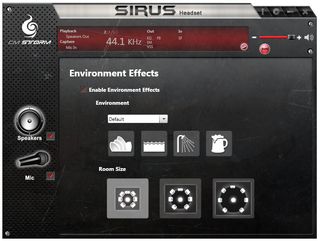
The Environment Effects page includes a number of options for altering perceived room size, amongst other tweaks.

Xear SingFX includes a number of real-time voice effect presets: monster, cartoon, male, and female. There is no option to customize each profile, though. We also noticed that, when voice effects are used, sound levels seem to drop.

The Virtual Speaker Shifter enables software-based re-positioning of perceived audio sources.

Cooler Master bundles its tactical mixing console, an analog cable end, a second set of ear cups with cloth finish (instead of leatherette), which is much more comfortable, and a quick start guide. You don't get a driver disk, but the included documentation tells you where the control software can be downloaded.
Current page: Cooler Master CM Storm Sirus
Prev Page Arctic Sound P531 Next Page Corsair Vengeance 1500Stay on the Cutting Edge
Join the experts who read Tom's Hardware for the inside track on enthusiast PC tech news — and have for over 25 years. We'll send breaking news and in-depth reviews of CPUs, GPUs, AI, maker hardware and more straight to your inbox.
-
cleeve spookiegreat read! Never thought virtual surround sound was that goodReply
Yeah, me neither. Surprised the hell out of me.
-
Thanks Toms for doing a review on 5.1 headsets. I been researching one for the past two weeks on other review websites, and online stores, but didn't feel satisfied. Could you guys do a review comparing these headsets you reviewed already to a dedicated audio card like the Asus Xonar Essence STX (with a pre amp) with a Sennheiser HD 598 Headphones (or HD 800)? I want to know if it is like night and day compared to these 5.1 headsets (also make readers see what they are missing from using onboard audio). I know its a few hundred dollars more, but i found out that i was more happy gaming with a $70 audio card than seeing 8x AA (using Nvidia Inspector) with a $500 GPU.Reply
-
cleeve bunnywannyCould you guys do a review comparing these headsets you reviewed already to a dedicated audio card like the Asus Xonar Essence STX (with a pre amp) with a Sennheiser HD 598 Headphones (or HD 800)? I want to know if it is like night and day compared to these 5.1 headsets (also make readers see what they are missing from using onboard audio).Reply
I like the idea, but it'll probably take a while to make it happen.
Next up on the audio to-do list is a full-sized 5.1/7.1 surround system comparo. :)
-
killeeeeer It would of been great if you tested the Roccat Kave but other than that great review. Been searching for headset for long time , now ill go with the Corsair Vengeance 1500 for sure .Reply -
crysex Thanks Toms so much for doing this review. I have been searching one for a long time. Ready to buy a good quality sound card + headset after my next paycheck!Reply -
iamtheking123 I'll stick to my $100 stereo headphones instead of $20 headphones + $80 spent on fake surround sound and marketing. We've all tried virtual surround sound in PowerDVD or WinDVD and it sucks. Makes everything sound underwater and no where close to having 5 actual speakers set up throughout a room.Reply -
tomfreak I am still sticking with more expensive traditional speakers, simply due to my ear need some air to breath. These headphone arent comfortable especially during summer.Reply
